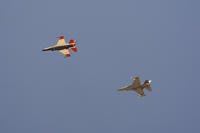Our friend Bob Cox sent us his latest jibe at the MV-22 Osprey.
Editor's note: From my standpoint I think Bob's criticism is unfair. I understand that the Marine Corps sold the Osprey as "self-deployable."
But keep in mind the plane is intended to replace the CH-46 Sea Knight - which cannot self-deploy at all. The Corps doesn't fly its much more powerful CH-53E Super Stallions to the war zone either, even though technically they are self-deployable due to their in-flight refueling capability. So why is it such a big deal that the Osprey isn't?
Also, there's nothing untoward in the Corps' desire to deploy the Osprey aboard an amphib for its first stint in the operational forces. If I were a maintainer, air boss or deck handler, I'd sure want to take all that at-sea time to work out the kinks that are bound to crop up with a flight deck - and hangar deck - filled with aircraft.
But Bob's been covering this program for a long time as well, so we at DT think it's important to present all sides in this important debate. One thing I think we can all agree on, however, is that we wish the VMM-263 Thunder Chickens the best of luck and a safe deployment next month.
From Bob's Sky Talk blog:
One of the key selling points of the V-22 Osprey, one that is repeated over and over by the Marines and the Bell Helicopter-Boeing contractor team, is that the aircraft can self deploy to combat. In other words, fly high and long distances to get from one base to a combat zone - say from the U.S. to Iraq - where it can there be put into tactical use on the battlefields.
Well, for their first combat deployment with the V-22 to Iraq next month the Marines will be going by ship, Navy Times is reporting.
Itll save wear and tear on the airplane, Lt. Col. Curtis Hill said. This will also allow time to do shipboard integration operations. That will help us down the road as we look to integrate them with the [Marine expeditionary units].
All along the Marines have viewed the V-22 as a dual role aircraft, able to operate from ships or land. But the self deployment capability is highlighted over and over and as a true revolutionary breakthrough, at least when compared to slower moving, lower flying helicopters.
Of course, the reliability record of the V-22 is such that the Marines probably don't want to take a chance on seeing several of the aircraft have to divert to landing spots along the way for repairs. The V-22s much ballyhooed trip to England last year for the Farnborough Air Show got even more attention when one plane diverted to Iceland due to engine troubles, later described as minor, and the return trip to the U.S. was delayed for other repairs.
-- Christian








